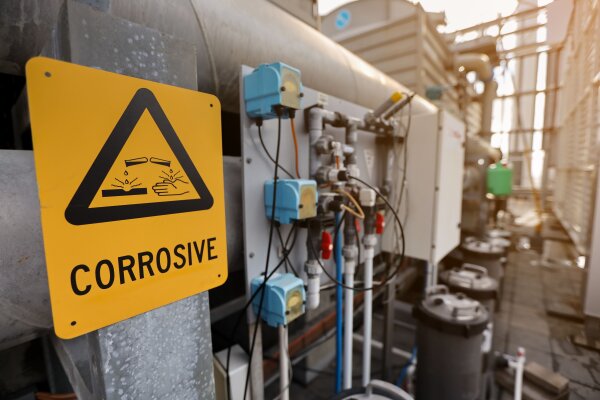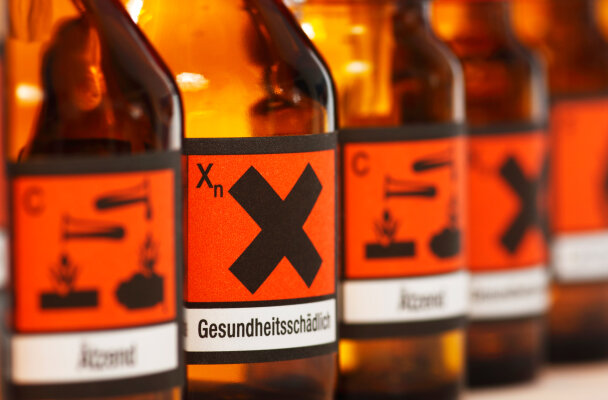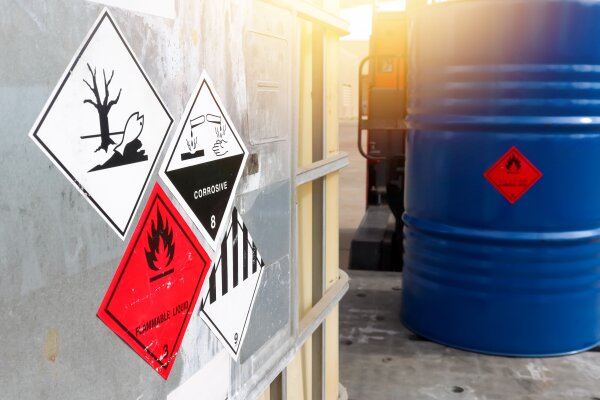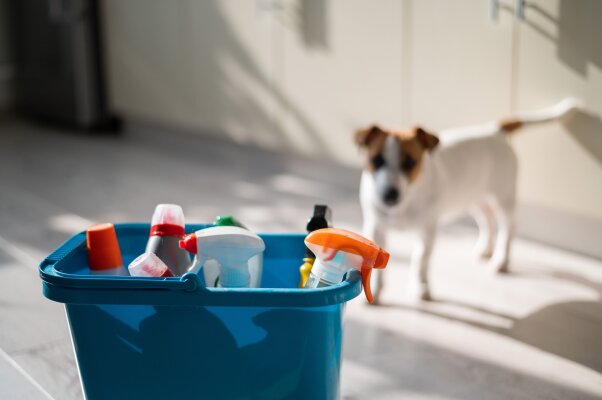Corrosive substances: all info on dangerous goods class 8

Everyone has probably come into contact with the term “corrosive substances”, as this is a group of substances that can be found in every household. Corrosive substances are grouped in dangerous goods class 8 and classified according to their properties. How they are classified, what health hazards they pose and what there is to know about storage and handling have been summarized compactly in this blog post.
Corrosive substances: definition
When we talk about corrosive substances, we are talking about substances with a corrosive effect. This means that they can attack surfaces and destroy living tissue, so caution is advised when handling them. The nature of the substances can differ: Both corrosive acids and alkalis can be assigned to this group. These are either organic or inorganic in nature.
Corrosive substances can exist in all three of the usual aggregate states, so that they are either solid, liquid or gaseous. Liquids are usually most dangerous when they wet the skin: There they act immediately and can cause great damage. Gases, on the other hand, must first be distributed on the tissue.
Known examples of corrosive substances include hydrochloric acid, sulfuric acid, soap lye and sodium hydroxide solution. Many representatives are constantly encountered in everyday life – for example, drain cleaners, acetic acid, ammonia or chlorine for water treatment are among them.
Important classifications of corrosive substances
In order to classify corrosive substances of dangerous goods class 8, different classifications are used. Whereas in the past the classification according to the substance directive was decisive, today the GHS/CLP and the dangerous goods directives in particular are elementary.
1. classification according to GHS/CLP
Regulation (EC) No. 1272/2008, also known as the CLP Regulation, is one of the EU chemical regulationsand, together with the GHS labeling (Globally Harmonized System of Classification and Labeling of Chemicals), forms the most important basis for labeling and handling corrosive substances. It came into force in 2019. According to this specification, the following distinctions are made:
Skin corrosive
The GHS symbol for “skin corrosive” is divided into three categories. These include “Skin Corrosive 1A” (skin corrosivity within 3 minutes), “Skin Corrosive 1B” (skin corrosivity after 3 minutes to 1 hour), and “Skin Corrosive 1C” (skin corrosivity after 1 to 4 hours).
Severe eye irritation/eye damage
In addition, there is a pictogram for corrosive substances that cause irreversible eye damage or severe irritation. This is given the category designation “Category 1:irreversible damage to the eye”.

Metal corrosive properties
Finally, the third group according to GHS/CLP are corrosive substances, which have metal corrosive effects and therefore do not represent a toxic hazard, but a physical or chemical hazard. They bear the note “Category 1: Corrosive to metals“.
1. classification according to dangerous goods regulation
In addition, there is a classification according to the applicable dangerous goods regulation, which is based on the dangerous goods guidelines. This defines various packaging groups for corrosive substances of dangerous goods class 8, which are particularly important for storage and transport. The classification is as follows:
- Packaging group I: Skin corrosivity within 3 minutes
- Packaging group II: Skin corrosivity after 3 minutes to 1 hour
- Packaging group III: Skin corrosivity after 1 to 4 hours
- Packing group IV: Corrosive to metals
2. obsolete classification according to substance directive
Incidentally, until 2015, Directive 67/548/EEC applied, which also classified corrosive substances according to specified criteria. Metal-corrosive substances were not taken into account. Goods with irreversible effects on the eyes were also not included. Under the name “Substance Directive”, the following categories applied at that time:
| Designation | Description | Criterion |
| R35 | Causes severe burns | When applied to healthy skin, the skin tissue is destroyed in its entire thickness after an exposure time of no more than 3 minutes |
| R34 | Causes burns | When applied to healthy skin, the skin tissue is destroyed in its entire thickness after an exposure time of 4 hours |
| R34 | Causes burns | Organic peroxides |
Health hazards of corrosive substances
Special precautions should be taken when handling corrosive substances, not least because of their sometimes highly hazardous properties. Otherwise, these can lead to pronounced tissue destruction and permanent damage to health. If you compare corrosive acids with alkalis, representatives of the second category are usually the worse culprit. Health hazards can be divided into the following areas:
- Skin: Mild skin irritation (for example, visible by redness) to severe damage to the skin. Underlying tissue may also be reached, resulting in the formation of necrosis.
- Eyes: In particular, splashes of liquid corrosive substances can severely endanger the eyes. Possible consequences are irritations as well as severe chemical burns, which can even lead to blindness.
- Respiratory tract: Gases, vapors and aerosols with corrosive effects, on the other hand, may attack the respiratory tract and cause respiratory irritation and/or severe, acute illness. Toxic pulmonary edema with respiratory distress may be cited as an example of chronic pulmonary disease resulting from corrosivity.
Properties of corrosive substances: C1 to C11
Although corrosivity to surfaces and living tissue is the core property of corrosives, they can have other characteristics. Therefore, representatives of this group of substances can be divided into further subgroups:
C1 to C4: acidic corrosive substances
The substance groups C1 to C4 contain substances with an acidic character, so that the pH value is below 7 in each case:
- C1: inorganic liquid substances
- C2:inorganic solids
- C3: organic liquid substances
- C4: organic solids
C5 to C8: basic corrosive substances
On the other hand, there are substances of the groups C5 to C8, which in turn have a basic character. The pH value is consequently above 7:
- C5: inorganic liquid substances
- C6:inorganic solids
- C7:organic liquid substances
- C8:organic solids
C9 to C11: other corrosive substances
Not every corrosive substance is either an acid or an alkali. If the substances do not fit into any of the preceding categories, they are placed in groups C9 to C11:
- C9: liquid substances
- C10: solids
- C11: Objects
Other classifications
In addition, there are other classifications that relate, for example, to the flammable and self-heating properties of some substances. These look as follows for corrosive substances:
| Classification | Features |
| CF | Corrosive flammable substances |
| CF1 | liquid substances |
| CF2 | solids |
| CS | corrosive self-heating substances |
| CS1 | liquid substances |
| CS2 | solids |
| CW | corrosive substances which, in contact with water, emit flammable gases |
| CW1 | liquid substances |
| CW2 | liquid substances |
| CO | corrosive toxic substances and objects containing such substances |
| CO1 | liquid substances |
| CO2 | liquid substances |
| CT | corrosive toxic substances and objects containing such substances |
| CT1 | liquid substances |
| CT2 | liquid substances |
| CT3 | Items |
| CTF | Corrosive flammable toxic liquid substances |
| COT | corrosive igniting oxidizing toxic substances |
Known corrosive substances and acids
Although we encounter corrosive acids and alkalis every day, they are not always recognized directly. This is often because many of these substances are known by trade names, so the actual name fades into the background. In addition to acids and alkalis, other corrosive substances are also affected.
Common points of contact with corrosive acids and alkalis are, for example, cleaning agents - where in many cases they are solid components. This also applies to the removal of greasy residues, for which caustic soda is usually used. Deposits, on the other hand, can be removed with acids (such as citric acid or acetic acid).
Alkalis
Common trade names of caustic solutions are, in particular, the following:
- Sodium hydroxide: Caustic soda, caustic soda, caustic soda, soapstone, caustic stone or caustic soda.
- Potassium hydroxide: Caustic potash, caustic potassium, caustic potash, potash hydrate or caustic potash.
- Sodium carbonate:soda ash or carbonic acid sodium
- Ammonia: ammonium hydrate, ammonium hydroxide or ammonia solution
- Calcium oxide:Lime earth, unslaked lime, burnt lime or quicklime.
- Calcium hydroxide: Slaked lime, milk of lime, calcium dihydroxide or Vienna lime
Acids
Traditionally, all acids whose salts occur in minerals are called mineral acids. In the meantime, however, it has become common practice that only three representatives (hydrochloric acid, sulfuric acid and nitric acid) are mentioned under this term. For common mineral acids, the colloquial names look like this:
- Hydrochloric acid: Hydrochloric acid
- Sulfuric acid: battery acid, vitriolic oil, accumulator acid or oleum.
- Nitric acid:Acidum nitricum
- Hydrofluoric acid: Hydrofluoric acid
- Phosphoric acid: Ortho-phosphoric acid
- Perchloric acid: superchloric acid or tetraoxochloric acid Tetraoxochlorsäure
For organic acids, these trade names should be familiar:
- Formic acid:methanoic acid, hydrocarboxylic acid, formionic acid, or Acidum formicicum.
- Acetic acid: ethanoic acid, methyl carboxylic acid, glacial acetic acid or Acidum aceticum
Other corrosive substances
In addition, there are a number of other corrosive substances that go by different names. For example, hydrogen peroxide is referred to as "active oxygen" when used in certain products. This also applies to active chlorine, which is usually sodium hypochlorite or chlorine bleach.
Handling corrosive substances
To protect yourself and others, special precautions apply when handling these substances. This includes ensuring that there is no skin, eye or lung contact, which is why suitable protective clothing is mandatory. In addition, there are important principles of prevention, so that accidents can also be prevented in the best possible way. These maxims are enshrined in law in the Hazardous Substances Ordinance.
Protective clothing
Personal protective clothing (PPE) is one of the elementary components when dealing with hazardous substances and, of course, must not be missing when dealing with corrosive acids and alkalis. This applies both to direct contact and when staying in the hazardous area. The PSA includes these elements:
- Eye protection: frame goggles with side protection or basket goggles
- Face protection: full face mask with multi-range filter against gases, vapors and aerosols as well as face protection (visor) in case of splash hazard
- Hand protection: Protective gloves made of resistant plastic material
- Body protection: aprons and boots (depending on the extent of the hazard)
In addition, both the workplace and the work equipment must be kept clean. This hygieneprevents contamination from occurring. Also, food, beverages and medications must be kept separate from the work area at all times to prevent them from coming into contact with the corrosive substances.
Principles of prevention
When selecting suitable protective measures, the prevention of hazards is the top priority. This is ranked "STOP" in the hazard assessment and must be adhered to:
| Letter | Bezeichnung | Explanation |
| S | Substitution | If hazardous substances can be replaced by less hazardous substances, the work procedure must be adapted accordingly. A new risk assessment must also be performed for the substitute substance or any substitute process. |
| T | Technical measures | Minimize the amount of hazardous materials to which workers are exposed. This includes closed systems, ventilation and exhaust systems. |
| O | Organizational measures | Reduction in the number of employees exposed to hazardous materials. In addition, there is the limitation of the quantity of hazardous substances and instructions as well as operating instructions. |
| P | Personal protective clothing | If a hazard exists, personal protective clothing must be provided and used by employees. |
Storage of corrosive substances
To ensure that the risk of corrosive substances can be minimized as best as possible,strict specifications also apply to storage. These affect both the storage tanks and the surrounding area. Thus, the stationary containers must have a suitable marking and must not be filled above the maximum permissible filling height.
Regulations for storage rooms
Only those areas that are above ground level can be considered for storage. Otherwise, there is a risk that heavy acid vapors can escape without volatilizing. Fire hazardous materials require fire retardant design of walls, floors, ceilings, windows and doors. In order to exclude groundwater hazards, liquid-tight catch basins must also be provided.
Incidentally, acids and alkalis may only be stored in a room if it is equipped with separate collection trays. To avoid the accumulation of vapors that are hazardous to health, each room must also have natural ventilation. In the case of outdoor storage, protection from the weather and a drip pan are mandatory.
Prohibitions for storage
In order to be able to guarantee a high safety standard, there areprohibitions for certain storage facilities. For example, it is not permitted to store corrosive substances of dangerous goods class 8 in traffic routes, workplaces, exits, passages, stairs, locks and ramps of any kind. Short-term parking on stairs or corridors is also strictly prohibited.
Storage regulations
In addition, the containers must not be placed on top of each other in any case to avoid accidents. Storage regulations also state that corrosive substances may not be stored with any other substances - although some MSDSs allow exceptions. Eye showers or eye wash bottles as well as a washing facility must be available if transfer and filling work is carried out in the warehouse.
Labeling of corrosive substances
When labeling, care must be taken to ensure unambiguousness and an appropriate hazard classification so that it can be recognized at first glance that the contents pose a hazard. To be able to ensure safe storage, this information should be noted on the containers:
- Trade name and chemical name
- Data on the supplier company (such as name and address)
- Hazard designation, hazard symbols, pictograms and identification letters
- R-phrases (hazard statements)
- S-phrases (safety advice)
- A current safety data sheet (according to EC Regulation 1907/2007, the so-called REACH Regulation)
Carriage of corrosive substances
Since corrosive substances are dangerous goods, their transportation is also subject to some rules and legal regulations. These include, above all, the Dangerous Goods Ordinance for Road, Rail and Inland Navigation (GGVSEB), including ADR, RID and ADN, as well as the Dangerous Goods Control Ordinance (GGKontrollV) and many others. In order to be allowed to transport a dangerous good, it must be marked with a danger label and a UC number.
In addition to the pictogram for dangerous goods class 8, the danger labels also contain inscriptions in numbers and letters that provide information on other hazardous properties. This becomes important in the event of an accident - it is the only way for the emergency services to know what hazards to expect. In addition, tightly sealed and shatterproof vessels are required. These must also bear the name of the substance, the corresponding pictogram and any other brief information.
There are also some substancesthat are not even approved for carriage. These include, for example, mixtures of hydrochloric acid and nitric acid (UN number 1978) and chemically unstable mixtures of waste sulfuric acid or nitrating acid. The same applies to perchloric acid and its mixtures.
Corrosive substances: the correct handling
In order to avoid hazards, the correct handling of corrosive substances is essential - this begins with the recognition of the substance and extends from classification to storage, handling and transport. At the top of the list is self-protection, so being thoroughly informed before coming into contact with Hazardous Materials Class 8 substances is of utmost relevance.
FAQ
Corrosive substances are a constant companion in everyday life. They are found, for example, in cleaning products(such as lime removers, floor and oven cleaners) and in skin care products, as well as in beverages and pools.
Although it is not uncommon for hydrochloric acid to be referred to as "the strongest acid," hexafluoroantimonic acid actually tops the list. It is formed by the reaction of hydrogen fluoride and antimine(V) fluoride.
When storing corrosive substances, it is important to ensure not only that the storage containers are suitable, but also that they are properly labeled. There are also factors such as suitable storage space and any storage bans that need to be taken into account.
Corrosive" refers to substancesthat can degrade surfaces and/or destroy living tissue. This means that they have a harmful effect on the eyes, skin and respiratory tract.
Do you have questions about the topic or would you like to suggest a topic? Please feel free to contact us by phone at +49 30 2096579 00 or send us an email to info@medsolut.com.




